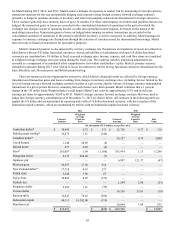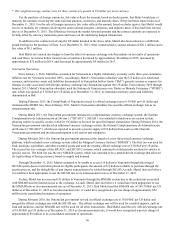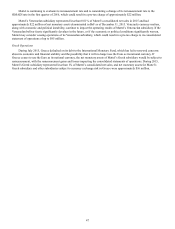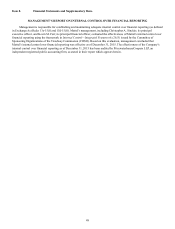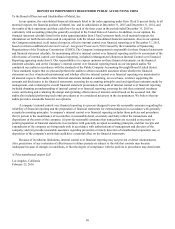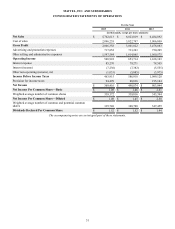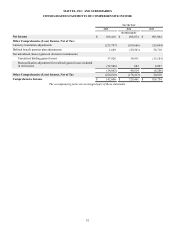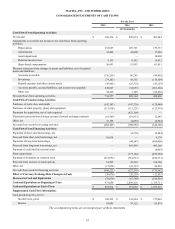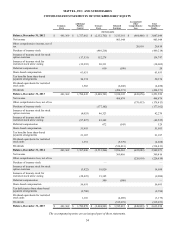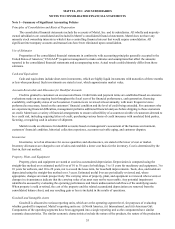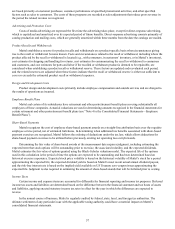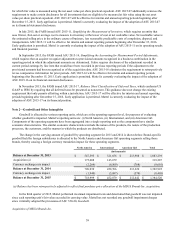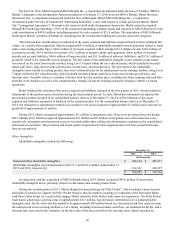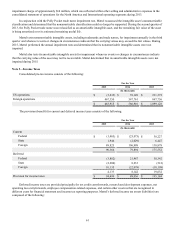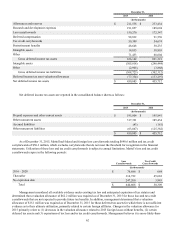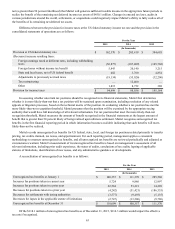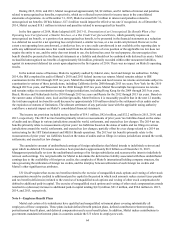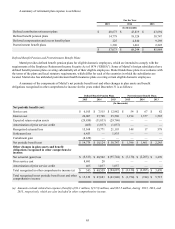Mattel 2015 Annual Report Download - page 59
Download and view the complete annual report
Please find page 59 of the 2015 Mattel annual report below. You can navigate through the pages in the report by either clicking on the pages listed below, or by using the keyword search tool below to find specific information within the annual report.55
MATTEL, INC. AND SUBSIDIARIES
NOTES TO CONSOLIDATED FINANCIAL STATEMENTS
Note 1—Summary of Significant Accounting Policies
Principles of Consolidation and Basis of Preparation
The consolidated financial statements include the accounts of Mattel, Inc. and its subsidiaries. All wholly and majority-
owned subsidiaries are consolidated and included in Mattel’s consolidated financial statements. Mattel does not have any
minority stock ownership interests in which it has a controlling financial interest that would require consolidation. All
significant intercompany accounts and transactions have been eliminated upon consolidation.
Use of Estimates
Preparation of the consolidated financial statements in conformity with accounting principles generally accepted in the
United States of America (“US GAAP”) requires management to make estimates and assumptions that affect the amounts
reported in the consolidated financial statements and accompanying notes. Actual results could ultimately differ from those
estimates.
Cash and Equivalents
Cash and equivalents include short-term investments, which are highly liquid investments with maturities of three months
or less when purchased. Such investments are stated at cost, which approximates market value.
Accounts Receivable and Allowance for Doubtful Accounts
Credit is granted to customers on an unsecured basis. Credit limits and payment terms are established based on extensive
evaluations made on an ongoing basis throughout the fiscal year of the financial performance, cash generation, financing
availability, and liquidity status of each customer. Customers are reviewed at least annually, with more frequent reviews
performed as necessary, based on the customers’ financial condition and the level of credit being extended. For customers who
are experiencing financial difficulties, management performs additional financial analyses before shipping to those customers
on credit. Mattel uses a variety of financial arrangements to ensure collectibility of accounts receivable of customers deemed to
be a credit risk, including requiring letters of credit, purchasing various forms of credit insurance with unrelated third parties,
factoring, or requiring cash in advance of shipment.
Mattel records an allowance for doubtful accounts based on management’s assessment of the business environment,
customers’ financial condition, historical collection experience, accounts receivable aging, and customer disputes.
Inventories
Inventories, net of an allowance for excess quantities and obsolescence, are stated at the lower of cost or market.
Inventory allowances are charged to cost of sales and establish a lower cost basis for the inventory. Cost is determined by the
first-in, first-out method.
Property, Plant, and Equipment
Property, plant, and equipment are stated at cost less accumulated depreciation. Depreciation is computed using the
straight-line method over estimated useful lives of 10 to 30 years for buildings, 3 to 15 years for machinery and equipment, 3 to
10 years for software, and 10 to 20 years, not to exceed the lease term, for leasehold improvements. Tools, dies, and molds are
depreciated using the straight-line method over 3 years. Estimated useful lives are periodically reviewed and, where
appropriate, changes are made prospectively. The carrying value of property, plant, and equipment is reviewed when events or
changes in circumstances indicate that the carrying value of an asset may not be recoverable. Any potential impairment
identified is assessed by evaluating the operating performance and future undiscounted cash flows of the underlying assets.
When property is sold or retired, the cost of the property and the related accumulated depreciation are removed from the
consolidated balance sheet, and any resulting gain or loss is included in the results of operations.
Goodwill and Intangible Assets
Goodwill is allocated to various reporting units, which are at the operating segment level, for purposes of evaluating
whether goodwill is impaired. Mattel’s reporting units are: (i) North America, (ii) International, and (iii) American Girl.
Components of the operating segments have been aggregated into a single reporting unit as the components have similar
economic characteristics. The similar economic characteristics include the nature of the products, the nature of the production


